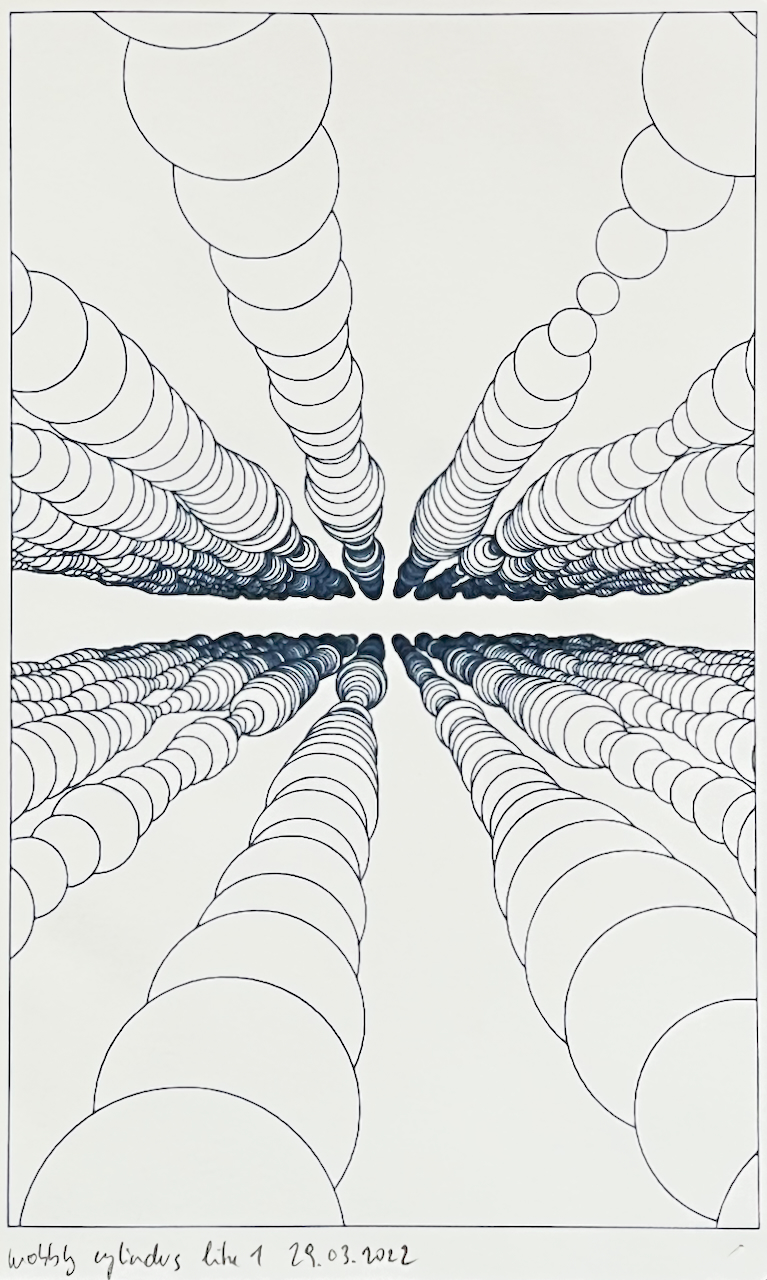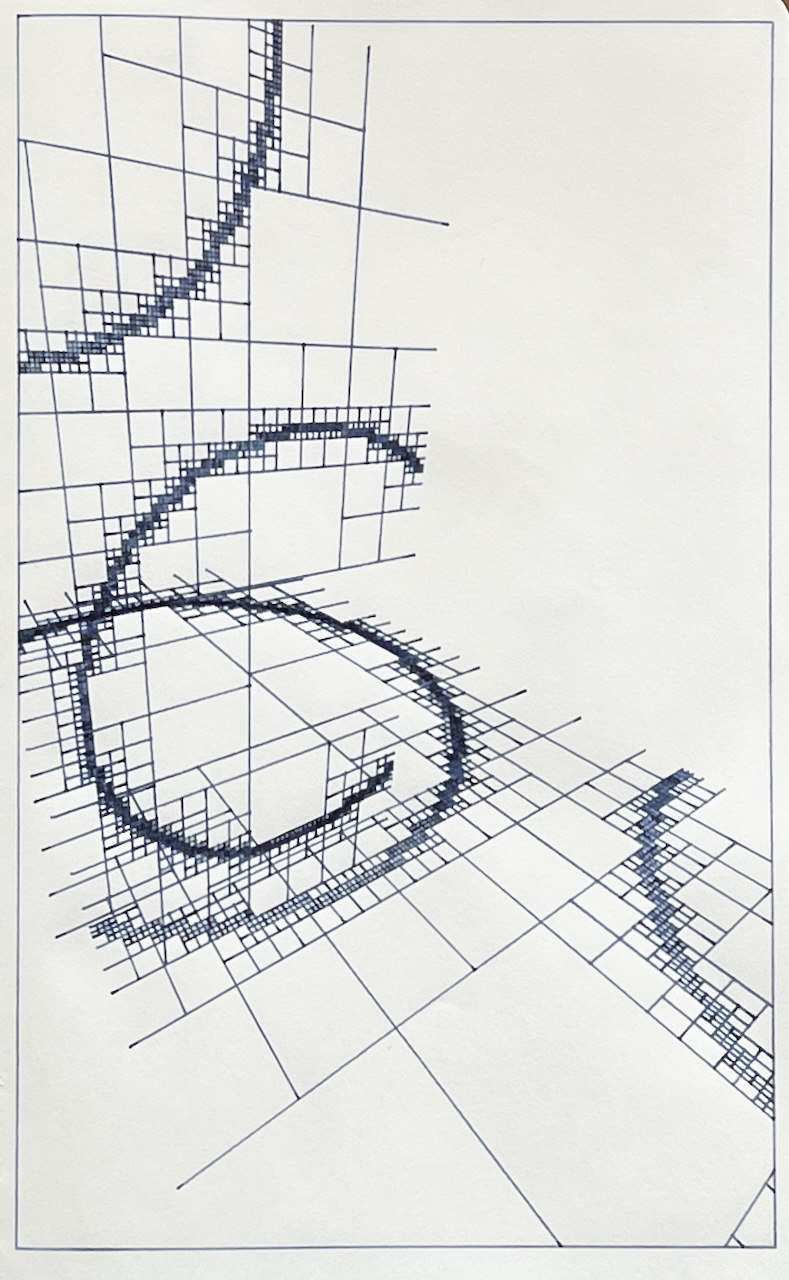Put your art in perspective with vpype.
Project description
vpype-perspective
vpype-perspective is a vpype plug-in to bring your 2D artwork in 3D space and render it in perspective. This project both aims to be a usable tool enabling new creative possibilities, and educational material demonstrating advanced uses of vpype and 3D computer graphics math basics.

Installation
Note: vpype-perspective requires vpype 1.10 or later.
If you haven't already, install vpype by following the installation instructions.
You can ensure that vpype is up-to-date with the following command:
$ pipx upgrade vpype
Then, add vpype-perspective to your vpype installation:
$ pipx inject vpype git+https://github.com/abey79/vpype-perspective
Check that your install is successful:
$ vpype --version
$ vpype perspective --help
[...]
Documentation
Note: the figures below have been created using vpype-perspective. The .vpy and corresponding .svg files are located in the examples/figures directory of the present repo.
Basic 3D layout
As starting point, the perspective command builds a 3D stack of layer. Each layer is a planar "quad" (flat, rectangular 3D surface) whose dimensions match the current page size (or, if it is undefined, the computed bounds of the geometries). The quads are aligned to the X and Y axes, and stacked along the Z axis. The Z position of each layer quad is determined by the corresponding layer ID, such that layer 1 lies at z = 0 and consecutive layer IDs are spaced by delta_z (which defaults to 1cm). The z position of layer N is thus z = (layer_ID - 1) * delta_z. The delta_z value can be overridden by using the pspread DELTAZ command before any other vpype-perspective command.
The perspective command uses a world coordinate system where the X axis points right (when facing a layer quad), the Y axis points up, and the Z axis is perpendicular to the layer quads and points in the direction of the layers with higher IDs. The origin of the world coordinate system thus lies in the middle of layer 1's quad. This is represented in red in the figures above.
Note that the X and Y axes of the world coordinate system do not match vpype's native coordinate system. In the world coordinate system, (0, 0) is in the middle of the layer and the Y axis pointed upward, while in vpype's coordinate system, (0, 0) is on the top-left corner of the layer and the Y axis is pointing downward.
By default, the camera faces the front-most layer quad (highest layer ID/z value) and its aiming point is in the middle of the rectangular cuboid defined by the front-most layer and layer 1 (the default aiming point world coordinates are thus (0, 0, (N-1) * delta_z / 2)) if N is the layer ID of the front-most layer). An alternative camera aiming point can be set using the --aiming-point PX PY PZ option.
The camera focal distance is chosen based on the desired horizontal field-of-view (which can be set using --fov). It is choose such that, will all default settings, the front-most layer is unchanged by the perspective command, and the other layers are increasingly scaled down the further they are. This can be demonstrated by the following command:
$ vpype \
pagesize 10x10cm \
repeat 5 \
rect -l %_i+1% 0 0 10cm 10cm \
text -l %_i+1% -p 0.1cm 0.2cm -s 12 "layer %_i+1%" \
end \
perspective --hfov 60 \
show
Using larger field-of-view yields stronger perspective distortion effects.
Camera control
The position and orientation of the camera can easily be altered using the --aiming-point, --pan, --tilt, and --move options of the perspective command.
The --pan option orbits the camera right (for positive angles) or left (for negative angles) around the origin, while keeping pointed at it.
Likewise, the --tilt option orbits the camera up (for positive angles) and down (for negative angles) around the origin, again keeping pointed at it.
Finally, the --move option translate the camera in the provided X, Y, and Z direction.
The camera translation is applied in the camera coordinate system, after the pan and tilt angles are applied (in this order). The order in which the options are passed to the perspective command does not affect the order in which they are applied. The following figure illustrate this order:
Note how, in the right-most example, the camera moved "over" the geometries. The camera was moved by 5cm in the Y ("up") direction *in the camera coordinate system". Since the camera pointing slightly downward due to the --tilt option, moving "up" in the camera coordinate system implies some forward horizontal displacement in the world coordinate system.
Modifying layers
Each layer can be individually manipulated in the 3D space using the pspread, protate, pscale, and ptranslate commands. These commands operate by setting or modifying custom properties. The perspective command then recognises these properties and apply the corresponding transforms to the geometry during the rendering process. The proplist command can be used to make this apparent:
$ vpype rect 0 0 10cm 15cm protate y 25 proplist --layer 1
listing 1 properties for layer 1
prsp_transform: (ndarray) [[ 0.90630779 0. 0.42261826 0. ]
[ 0. 1. 0. 0. ]
[-0.42261826 0. 0.90630779 0. ]
[ 0. 0. 0. 1. ]]
The pspread command overrides the default delta_z value and thus influences the positions of all layers but layer 1.
Important: pspread must be used before any other vpype-perspective command because they rely on the layer's position in space.
The protate command rotates the layer quad around the X, Y, or Z axis (in world coordinate). By default (--origin layer), the rotation is applied around the layer quad's center. Using --origin world, the rotation is applied around the world origin instead.
The ptranslate command translates the layer quad along the X, Y, and Z axis (in world coordinates). By default, the coordinates are considered offsets to be applied on the quad's current position. When using the --absolute option, the coordinates are instead considered as absolute values and the layer quad is translated such as its center lies on them.
On the right side of the figure above, all three translated layer quads are superposed, with their center lying on the [3cm, 0, 0] world coordinates.
The pscale command scales the layer quad by a factors along the X, Y, and & axis (in world coordinates). By default (--origin layer), the scaling is applied around the layer quad's center. Using --origin world, the scaling is applied around the world coordinate origin instead.
The commands may be chained to achieve complex transform of the layer quad.
Finally, the preset command resets the transform currently applied.
Development setup
Here is how to clone the project for development:
$ git clone https://github.com/abey79/vpype-perspective.git
$ cd vpype-perspective
Create a virtual environment:
$ python3 -m venv venv
$ source venv/bin/activate
$ pip install --upgrade pip
Install vpype-perspective and its dependencies (including vpype):
$ pip install -e .
$ pip install -r dev-dependencies.txt
License
See the LICENSE file for details.
Project details
Release history Release notifications | RSS feed
Download files
Download the file for your platform. If you're not sure which to choose, learn more about installing packages.
Source Distribution
Built Distribution
Hashes for vpype_perspective-0.1.0-py3-none-any.whl
| Algorithm | Hash digest | |
|---|---|---|
| SHA256 | fd0767cace1e73ce834800b28dc65b8f1bc26f554357604f1500fff99046ad03 |
|
| MD5 | 7c16f195e9a219962b9ca9ad9e0bd7ef |
|
| BLAKE2b-256 | ac9afbd506f00551a20b0bed79dfb034d5a96e0d0d3e2c646e77cc8b72f3a309 |
























